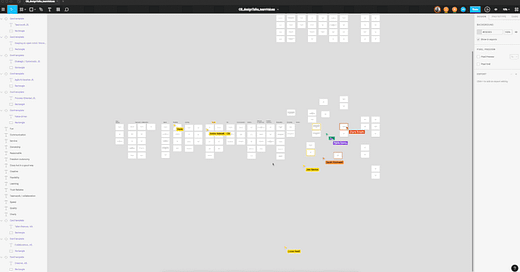It’s Design Lobster #68 and we’re looking at designs that carry traces of human life. From software that lets us see and feel the presence of other people, to tableware that bears the marks of its makers hands. 🤲
✨Enjoying Design Lobster? Please share it with a friend, colleague or fellow designer.
Question: How can we make other people feel present in software?
Like (I suspect) many of you, I spend my days in Figma, a design tool that offers the ability to see your coworkers working in the same file as one of its core features. As shown in the GIF above, each person’s cursor is made visible to everyone else and you can watch live as they move things around or make edits.
I was initially rather uneasy about this innovation, accustomed to a level of privacy in my design files that I didn’t want to relinquish. But I quickly began to find it quite remarkable how natural it felt to lead people around with your cursor and even beckon them to the correct section of your file with a wave. It somehow really feels like they are there with you in the same place.
I confess though that I still get nervous in my job when a senior executive suddenly drops in to take a look! 👀😬
With the sudden and rapid rise of video-conferencing, I think we’re at risk of overlooking other more abstract ways of representing human presence in software like these cursors. We probably don’t always need to see people’s faces to communicate well, just a sense of where their attention is and what they are thinking and feeling.
Design takeaway: How could your design communicate human presence?
✍️ Figma recently launched an online white-boarding tool call Figjam with even more imaginative ways of making your presence felt.
Object: Porcelain teapot
This delicate teapot was an early work by ceramicist Edmund de Waal. It is made of porcelain with a Celadon glaze giving it an enigmatic pale translucency that somewhat resembles jade. What is most striking for me are the small indentations in the surface of the teapot that show the presence of the potter’s hands. You can see a shallow thumb print on each side in the photo above, made when the clay was wet, in which your fingers would naturally nestle as you picked the teapot up.
I dislike anthropomorphizing objects, but I want to know what it has witnessed, whether I can talk of the memory of objects.
—Edmund de Waal
Edmund’s ceramics and his writing – he has written two bestselling books – are interested in the way material objects hold stories through the way they are made and used. This interest in memory manifests in his ceramics through design choices like the thumb prints – which make the maker’s presence tangible long after the mug or pot is fired.
Design takeaway: If your design had a memory, what would it contain?
▶️ A video exploring his studio in South London, just down the road from me.
Quote: “There is design and there is the research of the soul, of objects that will have contact with the souls of the people.”
– Alessandro Mendini
Alessandro Mendini designed the celebrated anthropomorphic Anna corkscrew that we looked at in Design Lobster #49. This quote felt like an important reminder that design is always (or always has the potential to be) emotional and at the very highest level even spiritual.
I find it a strong provocation for the start of the week – how might you touch someone’s soul in the design work you are doing right now?
Have a good one,
Ben 🦞
Enjoyed this week’s Design Lobster? Let me know by clicking the heart button.
👇





